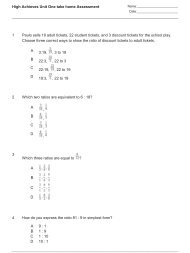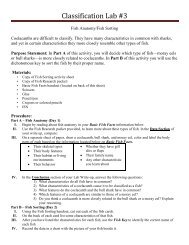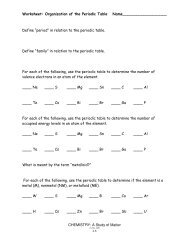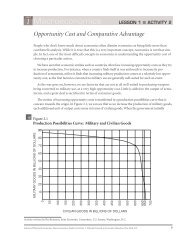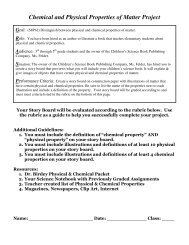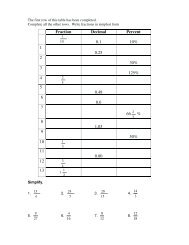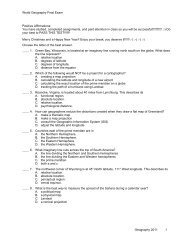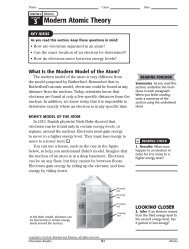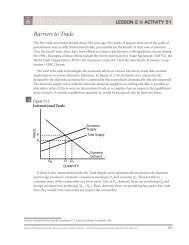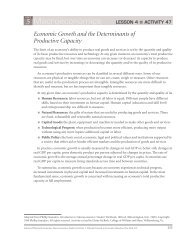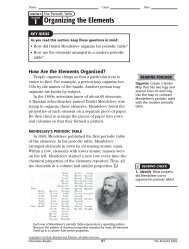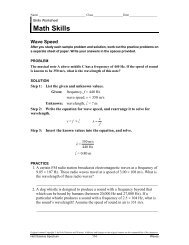Notes on Biogeochemical Cycles and Ecology.pdf
Notes on Biogeochemical Cycles and Ecology.pdf
Notes on Biogeochemical Cycles and Ecology.pdf
You also want an ePaper? Increase the reach of your titles
YUMPU automatically turns print PDFs into web optimized ePapers that Google loves.
nutrients from the inorganic nutrient pool, which is usually the soil or watersurrounding the plants or algae. These inorganic nutrients are passed from organism toorganism as <strong>on</strong>e organism is c<strong>on</strong>sumed by another. Ultimately, all organisms die <strong>and</strong>become detritus, food for the decomposers. At this stage, the last of the energy isextracted (<strong>and</strong> lost as heat) <strong>and</strong> the inorganic nutrients are returned to the soil or waterto be taken up again. The inorganic nutrients are recycled, the energy is not.Many of us, when we hear the word "nutrient" immediately think of calories <strong>and</strong> thecarb<strong>on</strong>-carb<strong>on</strong> b<strong>on</strong>ds that hold the caloric energy. IT IS VERY IMPORTANT thatyou be careful in your use of the word nutrient in this sense. When writing aboutenergy flow <strong>and</strong> inorganic nutrient flow in an ecosystem, you must be clear as to whatyou are referring. Unmodified by "inorganic" or "organic", the word "nutrient" canleave your reader unsure of what you mean. This is <strong>on</strong>e case in which the scientificmeaning of a word is very dependent <strong>on</strong> its c<strong>on</strong>text. Another example would be theword "respirati<strong>on</strong>", which to the laypers<strong>on</strong> usually refers to "breathing", but whichmeans "the extracti<strong>on</strong> of energy from carb<strong>on</strong>-carb<strong>on</strong> b<strong>on</strong>ds at the cellular level" tomost scientists (except those scientists studying breathing, who use respirati<strong>on</strong> in thelay sense).To summarize: In the flow of energy <strong>and</strong> inorganic nutrients through the ecosystem, afew generalizati<strong>on</strong>s can be made:1. The ultimate source of energy (for most ecosystems) is the sun2. The ultimate fate of energy in ecosystems is for it to be lost as heat.3. Energy <strong>and</strong> nutrients are passed from organism to organism through the foodchain as <strong>on</strong>e organism eats another.4. Decomposers remove the last energy from the remains of organisms.5. Inorganic nutrients are cycled, energy is not.Food Chains <strong>and</strong> Webs:A food chain is the path of food from a given final c<strong>on</strong>sumer back to a producer. Forinstance, a typical food chain in a field ecosystem might be:grass ---> grasshopper --> mouse ---> snake ---> hawkNote that even though I said the food chain is the path of food from a given finalc<strong>on</strong>sumer back to a producer we typically list a food chain from producer <strong>on</strong> the left(or at the bottom) to final c<strong>on</strong>sumer <strong>on</strong> the right (or at the top). Note to internati<strong>on</strong>alreaders: In Hebrew or Aramaic, or other languages which are read right-to-left, is itcustomary to list the food chains in the reverse order? By the way, you should be ableto look at the food chain above <strong>and</strong> identify the autotrophs <strong>and</strong> heterotrophs, <strong>and</strong>



